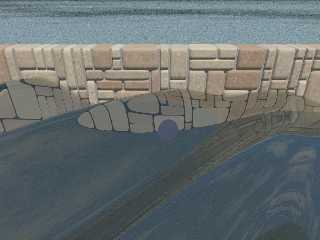 |
 |
|
 |
|
 |
|  |
|  |
|
 |
|
 |
|  |
|  |
|
 |
I'm guessing it's going to be me that's wrong BUT...
Does the texturing on the attached image look correct? it seems that as
soon as the light is going through my water (an ior'd isosurface), the
texture (but not pigment) is removed from the bricks.
If this is accurate, would someone be kind enough to let me know?
Thanks
Simon
Post a reply to this message
Attachments:
Download 'bricks074.jpg' (42 KB)
Preview of image 'bricks074.jpg'

|
 |
|  |
|  |
|
 |
|
 |
|  |
|  |
|
 |
Simon wrote:
> Does the texturing on the attached image look correct? it seems that as
> soon as the light is going through my water (an ior'd isosurface), the
> texture (but not pigment) is removed from the bricks.
Possibly your surface shadows the bricks so you only get ambient
light, in which case you don't see normals or shading.
Post a reply to this message
|
 |
|  |
|  |
|
 |
|
 |
|  |
|  |
|
 |
Christian Froeschlin wrote:
> Simon wrote:
>
>> Does the texturing on the attached image look correct? it seems that
>> as soon as the light is going through my water (an ior'd isosurface),
>> the texture (but not pigment) is removed from the bricks.
>
> Possibly your surface shadows the bricks so you only get ambient
> light, in which case you don't see normals or shading.
Thanks. I imagine that's exactly what it is. Do you know how I can stop
the surface doing that? I suppose I could use no_shadow?
Failing that, I was planning on adding photons - would they show the
shading/normals ?
Thanks
Simon
Post a reply to this message
|
 |
|  |
|  |
|
 |
|
 |
|  |
|  |
|
 |
Or you could use "real bricks" instead of a normal perturbation :)
Post a reply to this message
|
 |
|  |
|  |
|
 |
|
 |
|  |
|  |
|
 |
Nicolas Alvarez wrote:
> Or you could use "real bricks" instead of a normal perturbation :)
Sounds like what I need - so whilst bump mapping won't show, if I
actually perturb the surface, it should look fine. does that sound correct?
Seriously, the more pointers anyone can give me, the better.
Thanks :)
Simon
Post a reply to this message
|
 |
|  |
|  |
|
 |
|
 |
|  |
|  |
|
 |
Simon <povray@*NOSPAM*SOWare.co.uk> wrote:
> Nicolas Alvarez wrote:
> > Or you could use "real bricks" instead of a normal perturbation :)
>
> Sounds like what I need - so whilst bump mapping won't show, if I
> actually perturb the surface, it should look fine. does that sound correct?
>
> Seriously, the more pointers anyone can give me, the better.
Radiosity with normals turned on instead of standard ambient light might work as
well, though it may be slower than other methods.
-The Mildly Infamous Blue Herring
Post a reply to this message
|
 |
|  |
|  |
|
 |
|
 |
|  |
|  |
|
 |
Have you tried double_illumination in your water?
-Nekar
Post a reply to this message
|
 |
|  |
|  |
|
 |
|
 |
|  |
|  |
|
 |
Simon <povray@*NOSPAM*SOWare.co.uk> wrote:
> Nicolas Alvarez wrote:
> > Or you could use "real bricks" instead of a normal perturbation :)
>
> Sounds like what I need - so whilst bump mapping won't show, if I
> actually perturb the surface, it should look fine. does that sound correct?
You could use isosurfaces (slow), or my mesh brick macro:
http://www.infradead.org/~wmp/macro_bricks.html
You won't need very high-res meshes to do what you want so it should parse
really quickly. :)
Post a reply to this message
|
 |
|  |
|  |
|
 |
|
 |
|  |




![]()